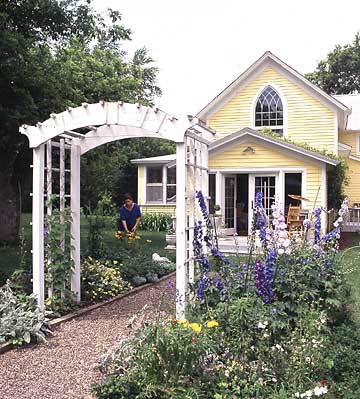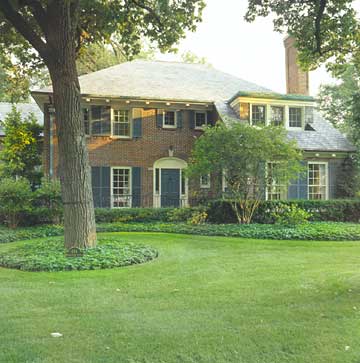





 If you'd like to spread thecost of your landscaping overseveral years, it makes senseto plant trees first becausethey take the longest to mature.
If you'd like to spread thecost of your landscaping overseveral years, it makes senseto plant trees first becausethey take the longest to mature.
The pleasure of landscape planning is all about dreaming, rather than worrying about costs or who will do the work and when. Once your plan is in place, the time has arrived for wise planning, which includes comparing costs as well as scheduling the work, whether you tackle it yourself or hire someone else to do it.
Using your final design, make a list of every major component. Most plans call for some work that's beyond your capability, time, or desire to do it yourself. Start contacting landscaping professionals. Also do comparison shopping for materials.
To devise a budget for landscaping, compare what you think you can spend (what your resources allow) and what you think you should spend (what the best quality materials cost). On average, budget 15 to 25 percent of your new home's price to install your dream landscape. Budget 5 to 15 percent of your home's value to renovate an established property. If you keep your expenses within this range, your landscaping efforts are most likely to boost the value of your property.
continue reading belowTo help finalize your budget, make a chart that has room for each item on your list followed by three columns, labeled A, B, and C. Fill column A with the cost of your ideal choice for each particular feature or task. When you are finished, add up all the numbers to see if you are within your budget.
If that number is too high, go back through the list and make changes to the amount or quality of materials, or even delete some items. Put those numbers in column B. After adding that up, if you are still over your desired budget, repeat the process in column C.
As you go through this exercise, assume you can save half the cost of a hired job if it is within your skill level to do it yourself. If you plan to stretch out the installation over several years, keep in mind that the cost for some products and services may increase over time.
As you figure costs for each item on your plan, start thinking about your priorities. First, do the things that would most likely increase the resale value; such as the construction of a deck, front entry, and retaining walls or the purchase of trees and shrubs. Also include costs for the essentials that will be scheduled first, such as tearing out old landscape features, site grading, drainage system installation, and bed building. Add in the costs of other basics, including paving, lighting, and plants. Be realistic about the cost of maintenance, and include it in the budget.
As you figure costs for each item on your plan, a project and priority list will take shape. Stick with your plan. Think twice if a contractor pushes you to install a waterfall when you want only a pond. It's your landscape and you have the final say.
 When you begin to implement your landscape plan, start by building fixed structures such as arbors, fences, and paths, then proceeding with planting beds.
When you begin to implement your landscape plan, start by building fixed structures such as arbors, fences, and paths, then proceeding with planting beds.
Make patience and flexibility your steadfast partners in any landscaping venture. Continue your step-by-step approach to landscaping by determining a plan of action now. Just as you must budget the costs over time, determine what needs to be done and the order of projects.
Whether your plan is large or small -- entailing weekends or years -- it's always worthwhile to think things through and take your time when making decisions. For example, it's better to wait a month after installing a patio before planting around it. In that time, you may realize that you overlooked a good view or miscalculated the angle of the summer sun. Instead of planting a few shrubs, you decide that an arbor would be more suitable. Moral of the story: Don't rush the work. Set a pace that allows you to enjoy the process.
 Plant new turf last to preventdamage caused by otherconstruction such as stonewalls and garden beds.
Plant new turf last to preventdamage caused by otherconstruction such as stonewalls and garden beds.
If you're anxious to get started, however, you'll hardly go wrong by planning to do the following projects first (because you'll see huge improvements before long). Deal with drainage and soil improvement issues.
Remember, landscaping is an ongoing process. As yards and gardens continually evolve, there's always another project -- more fun and challenge -- on the horizon.
Copyright © www.100flowers.win Botanic Garden All Rights Reserved